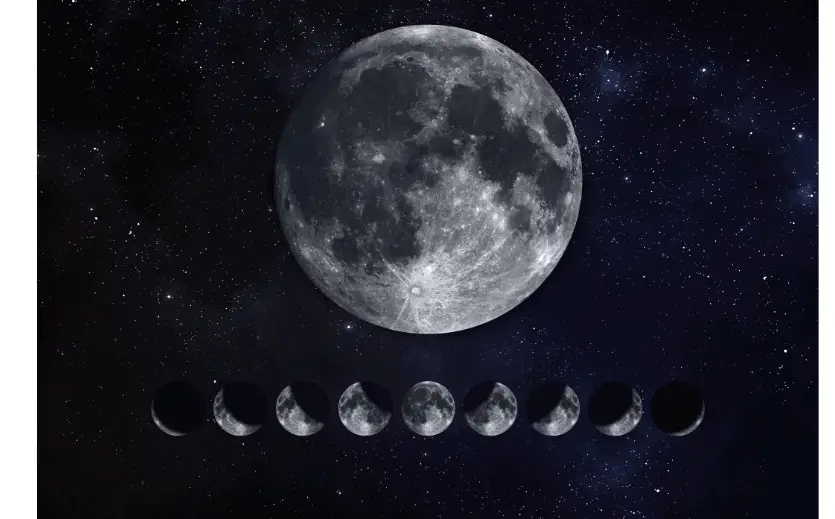
Anglers have attributed fishing success and failure to solunar effects for ages. Many feel that the moon phase greatly influences fish’s attitude. Those of you who rely on solunar information may be surprised at some of the findings below.
I began to wonder if there was truth to popular beliefs that moon phases are related to bass fishing, so I embarked on a journey to explore and discover more through research and data analysis.
I’ve gathered and read reports and books and listened to anecdotal information about the moon and its effects. Below, you’ll see a careful analysis of my research, including 5 Major theories.
The moon phase does affect bass fishing, but mostly in tidal fisheries because bass migrate to areas where the movement of the tides impacts bait fish availability. However, there does not appear to be supporting research or data to support a correlation between the moon phase and bass feeding behavior in non-tidal waters, except lunker fish catch rates may be affected.
Be sure to read the compelling study below for some surprising connections (or lack thereof) between moon phases and bass fishing.
What are the Moon Phases?
There are 8 phases of the moon pictured below.
- New Moon Phase — Actually, not pictured below because there’s nothing to see! During the new moon phase, the moon is still present (obviously) but not visible to the naked eye. The moon is located between the Earth and the sun, so it cannot be seen.
- Waxing Crescent – Moon appears like a crescent and seems to grow larger from day to day.
- First Quarter – Also known as a half moon. Arrives one week after the new moon.
- Waxing Gibbous – Observers can see more than half of the moon, and the portion you can see increases daily (the moon appears to get bigger daily).
- Full Moon – The entire moon is visible.
- Waning Gibbous – Observers can see more than half of the moon, and the portion you can see decreases daily (the moon appears to get smaller each day).
- Third Quarter – Also known as a half moon.
- Waning Crescent – The moon appears as a crescent that decreases in visible size daily.
The big question that many have is: which moon phase is best for bass fishing? The answer may surprise you. Read on below for conclusions that you may not expect.
How Does the Moon Affect Tides for Fishing?
The moon and its relative gravitation affect tides. But how?
The moon exerts a gravitational pull on the side of the earth that the moon is on, so the water in the oceans rises on the side of the planet that the moon is on and falls on the opposite side.
Do Solunar Tables Really Matter for Bass Fishing? (Be Surprised)
I’ve uncovered five influential research studies I’ve analyzed to dig deeper into moon phase fishing theories.
1. Solunar Theory
According to the solunar theory proposed by John Alden Knight (1926), there are MAJOR and MINOR periods of feeding that are related to the earth’s and moon’s gravitational forces. Knight analyzed data from over 200 lunker fish catches in his study. (source)
He observed several significant trends:
- First, he found that 90 percent of the large catches occurred during a new moon.
- He also noticed that more fish were caught during specific time periods that recurred each day based on the moon’s position in the sky related to its monthly orbital position (around the Earth).
- These major and minor times occur daily: two major feeding periods and two minor periods. (source). These periods usually last about an hour and a half and can be located in many online solunar tables.
Moon phase fishing proponents believe that these four daily major and minor periods that occur about every 6 hours are the best times each day to catch fish because fish become more aggressive, looking for prey during those times.
Those who believe in this theory lean heavily on lunar forecasts to help them plan fishing trips because they believe moon phases affect fishing.
2. Larry D. Hodge, as Published in Texas Fish and Game
A 2004 study published by Texas Fish and Game found the following:
- Twenty-two percent of lunkers were caught within two days of a full moon (either before or after).
- Fourteen percent within two days of a new moon (before or after).
- Sixty-four percent were caught during different times of the month (moon cycle).
- The same study indicated that Saturdays and Sundays accounted for almost 40 percent of all big fish catches.
So, did the fish know what day it was? NOT! It’s likely a product of more fisherman fishing on the weekends. The same could hold for full and new moons — more people fish them, so more big fish are caught. (source)
3. Kevin Story, Lake Fork Biologist
Story studied big bass catches at Lake Fork in March 2003 and 2004. The study found the following:
- More large bass were caught on or near the full moon.
- High catch rates were also noticed in and around new moon periods.
- Lunker catch rates also spiked near the two half-moon periods, affirming the theory that moon phases may affect catch rates. (source)
4. Doug Hannon’s Research
Famous bass angler Doug Hannon known for catching over 800 bass exceeding 10 pounds, was a serious student of bass behavior. Hannon was an avid angler and known to frequent bass habitats with his scuba gear. He also maintained detailed fishing journals and records that allowed him to cross-reference times, conditions, and more in his quest to uncover bass feeding and habitat patterns.
Hannon believed the following:
- Bass spawn according to a natural clock related to moon phases, and it’s done naturally to give offspring a better chance of survival. (source)
- He believed that the moon does affect bass and their interest in feeding. Whether the moon affected the bass or the forage, they sought was irrelevant. Either way, bass were affected by lunar cycles, especially lunker bass.
5. Josh Alwine. High Percentage Fishing (Alwine, 2016)
Perhaps, the most compelling study of moon phases and bass fishing comes from Josh Alwine’s book High Percentage Fishing (2016). Alwine uses a dataset from thousands of fish catches to test 3 widely held beliefs about moon phases and fishing. His statistical analysis leads to some surprising results, according to Alwine.
- Alwine contends that the moon does exert a gravitational pull that affects tides but that the subject bodies of water have to be enormous for them to be affected by those tides. By his math, the force of gravity on bass by the moon is tiny at .00006 pounds, not enough, according to him, to impact bass behavior.
- He also asserts that the moon’s gravitational force can increase when the moon is up, but the change is so minimal that it is insignificant (only 1.5 percent stronger or .000061 pounds of force).
- Alwine states that, as of his writing, there were no studies on the minimum gravitational force that bass could feel, but he believes that other feeding factors have a MUCH more significant impact than gravity, as you’ll see in his hypotheses tests below.

Test for Theory 1: The moon’s gravitational pull affects fishing.
7.3% of all fish were caught during the part of the fishing season where the moon had the strongest pull (closest to Earth), whereas 9% of all fish were caught when the moon had its weakest impact (farthest from the Earth). Because of the slight statistical differences, Alwine rejected the belief that the moon’s gravity significantly impacted fishing.
Test for Theory 2: The light produced by the moon affects fish catch rates.
Alwine’s data analysis showed that 14% of all fish were caught during the new moon (minimum light produced by the moon), while 17% were caught during the full moon (maximum light produced by the moon). He stated that there would have been a much bigger difference in fish catch rates if the light from the moon had an impact on fishing.
Test for Theory 3: Moonrise and moonset positively affect fishing.
Catch rates at moonrise and moonset were about 20% based on his data analysis (20 percent of fish were caught within one hour of moonrise and moonset). Catch rates hit a maximum during the full and new moons of 25% (full moon) and 28% (new moon). Alwine defends the higher full and new moon catch rates because he believes that full and new moon catch rates are related to higher sunrise and sunset catch rates.
After he mathematically removes the bias for sunset and sunrise during the full and new moon, the rates dip to 13%, almost the exact rate during any other random daylight hour. According to Alwine, the conclusion is that moonrise and moonset times do not positively or negatively affect fishing.
Finally, Alwine refutes Doug Hannon’s assertion and study from Big Bass Magic, published in 1986. Hannon contended that lunar cycles and fishing success were related. In his research, Hannon charted world record catches between 1970 and 1979 concerning the moon’s phases.
That study showed a relationship between lunar cycles and big fish catches. Alwine contends that Hannon overinflated fish catch rates by including too many days in his study.
Once amended by Alwine, the correlation between big fish and lunar cycles virtually vanished. Suffice it to say it warrants a closer look if you want further details. For more information, check out High Percentage Fishing by Josh Alwine.
How Does the Moon Affect Bass? Do Moon Phases Really Affect Fishing?
In landlocked, nontidal waters, it appears unlikely that the moon affects bass fishing as much as many think because gravity has no chance to impact tides in these non-tidal waters.
In tidal waters (substantial bodies of water), the moon phase likely affects the prey of bass more than the bass, but the result and impact are the same.
The crux of the issue revolves around the tidal issue. In my opinion and from the research I’ve reviewed, fisheries with a tide element will be more susceptible to moon phase influence because gravity affects tides, tides affect baitfish movement, and baitfish movement affects bass’ appetites and feeding interests.
It likely does not affect the number of fish caught but may affect lunker catch rates because of the causal connection between the full and new moon and spawning behavior. However, how do we remove the bias for more fishermen being interested in fishing during new and full moon periods? To my knowledge, it hasn’t been done.
Perhaps, my sentiment on moon phase fishing can best be summed up by world-renowned professional angler Kevin VanDam,
“I pay attention to moon phases. I just don’t rely on them to tell me everything “…” (source)
Related Questions
How is Bass fishing the Morning After a Full Moon?
Conventional theory and anecdotal “talk” lead many to believe that bass do not eat much the day after a full moon because the moon has provided enough light for them to forage and eat during the entire night of the full moon. However, I’ve not found any basis or research to support this contention, and I still catch fish after a full moon.




